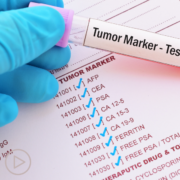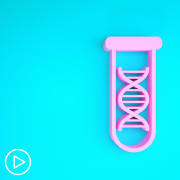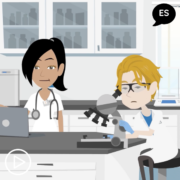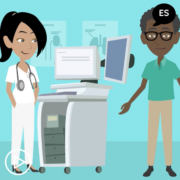Socios para el Cuidado del Cáncer de Próstata: Obtener el Apoyo que Necesita from Patient Empowerment Network on Vimeo.
¿Qué deben saber los cuidadores para ayudar a cuidar de su ser querido Y de sí mismos? Este video animado repasa el papel de un cuidador, analiza los pasos para apoyar a un ser querido y ofrece consejos para mantener el autocuidado.
Descargar Guía
See More From Shared Decision Making: Navigating Prostate Cancer Care
Related Resources:
Transcript:
Anthony:
¡Hola! Soy Anthony y vivo con cáncer de próstata avanzado. Esta es mi enfermera, Niki.
Y esta es mi esposa, Jane. Ella no es solo mi esposa, también es mi compañera de cuidado. Desde ayudar con mi horario de citas hasta comunicarme con mi equipo de atención médica, ella trabaja conmigo para controlar mi cáncer de próstata.
Jane:
Y muchos de ustedes pueden ser compañeros de cuidado como yo. El objetivo de este video es ayudarlo a comprender su función y obtener herramientas que lo ayuden a apoyar a su ser querido en su jornada contra el cáncer. Y eso incluye priorizar su propio cuidado personal.
Niki, nosotros hemos hablado sobre algunas de las cosas que yo hago para ayudar a Anthony, pero ¿cómo describirías el papel de un compañero de cuidado?
Niki:
Un compañero de cuidado es alguien que trabaja con su ser querido en su cuidado en cada paso del camino – desde el diagnóstico hasta la supervivencia.
Es importante mencionar que cualquier persona puede desempeñar este papel – amigo, un miembro de la familia o un ser querido, en quien confíe para apoyar su salud.
Jane:
Y no hay una sola manera de ser un compañero de cuidado. Usted puede brindar apoyo de una manera que se sienta cómodo y natural para usted.
Niki, ¿cuáles son algunas de las formas en que un cuidador puede ayudar?
Niki:
Sí – vamos a revisar algunos pasos. Los cuidadores pueden ayudar al:
- Aprender sobre el cáncer de próstata de su ser querido, para que pueda sentirse seguro al participar en conversaciones y decisiones. Usted puede solicitar recursos educativos a su equipo de atención médica.
- Y participar en las citas médicas tomando notas y solicitando resúmenes posteriores a la visita para que usted pueda revisar la información presentada.
- Luego, ayudando a su ser querido a acceder y usar su portal para pacientes y manteniendo horarios y organizando registros médicos.
- Escuchando a su ser querido y ayudar a sopesar los pros y los contras de las decisiones de atención.
- Y monitorear la salud emocional de su ser querido.
Jane:
Ese es un gran punto, Niki. A veces, un compañero de cuidado notará que su ser querido se siente deprimido o actúa de manera diferente antes de que ellos mismos noten algo. Los socios de atención pueden ayudar a comunicar estos problemas al equipo de atención médica e incluso pueden comunicarse con un profesional de salud mental o trabajador social para ayudar.
Niki:
Y eso me lleva al siguiente paso importante que muchos cuidadores a menudo pasan por alto: Cuidarse uno mismo.
Anthony:
Correcto, y como experimentamos de primera mano, esto es esencial. Jane luchó por hacer tiempo para sí misma después que a mí me diagnosticaron, y eso afectó negativamente su salud.
Jane:
Yo estaba totalmente agotada. Pero agregando tiempo para mí en el calendario y manteniéndome al día con mis citas de cuidado personal me hizo sentir mejor. ¿Qué más puede uno hacer?
- Primero, priorice su salud programando y manteniendo su PROPIA cita de atención médica.
- Continúe haciendo las actividades que usted disfruta – hay formas de hacer tiempo en el horario, incluso si no lo parece.
- Encuentre y use estrategias que funcionen para usted para manejar el estrés, como hacer ejercicio, leer un libro o cualquier cosa que usted encuentre relajante. Incluso una corta caminata con un amigo puede tener un gran impacto.
- Y haga una lista de tareas que usted le puede pasar a amigos y familiares que se ofrecen a ayudar.
Niki:
Ese es un gran consejo, Jane. También agregaré que luchar por un ser querido puede ser un desafío – es normal sentir una variedad de emociones. Si se siente abrumado, hablar con alguien sobre cómo se siente puede marcar la diferencia. Y hablar con franqueza y abiertamente con otros socios de atención en un entorno de grupo de apoyo también puede proporcionar consuelo y tranquilidad.
Al igual que Anthony buscó el consejo de un consejero y trabajador social, es importante que Jane encuentre ese apoyo que ELLA necesita como compañera de cuidado.
Jane:
Esperamos que este video le haya ayudado a obtener herramientas y estrategias para ayudar a apoyar a un ser querido – y uno mismo.
Anthony:
Descargue la guía que acompaña a este video para revisar lo que usted aprendió.
Y visite powerfulpatients.org/PC para acceder a más videos con Niki y conmigo.














